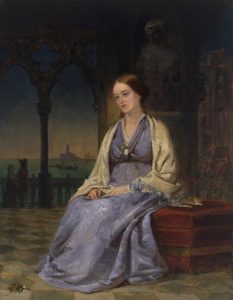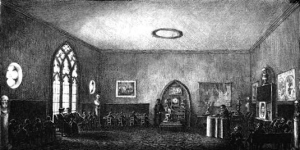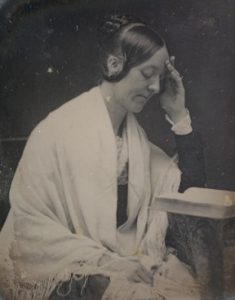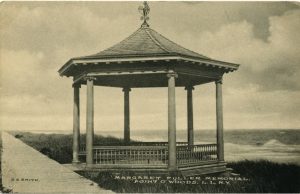
Margaret Fuller: The Early Years
Margaret Fuller once recalled that in childhood she “had stopped . . . one day on the stairs, and asked, how came I here? How is it that I seem to be this Margaret Fuller? . . . What shall I do about it?” She was evoking both the place of her birth and the introspective, active mind that would direct her life. Sarah Margaret Fuller was born on 23 May 1810 to Margaret Crane Fuller and Timothy Fuller in the “Port” neighborhood of Cambridge, Massachusetts. Timothy, a Harvard-trained lawyer, served as a state and then U.S. congressman whose job required him to be away from home for six months of the year. Both at home and by letter, her father Timothy rigorously educated his young first-born in reading, writing, and, beginning at six, Latin. Fuller’s “Autobiographical Romance” recalls his teaching as so demanding that she experienced nightmares and ongoing physical distress. Yet he also aroused a sense of exceptionalism and ambition in the child. At the same time her mother, with a garden of flowers behind the house, inspired a deep sense of beauty and aspiration. Her first home saw the growth of both an introspective mind and a potential commitment to action.
Fuller’s early growth was further enabled through individual tutoring by others and her attendance at several private schools. At Susan Prescott’s boarding school the adolescent gained a mentor in the teacher; returned home, Fuller acknowledged that Prescott’s inspiration, along with a determination to distinguish herself, motivated her continuing daily study. After Timothy moved the Fuller family to a home located a short distance from Harvard College, even as classes there remained closed to women, Fuller took advantage of its academic and religious circles to expand her learning through self-culture and socializing. She taught herself German and read philosophy, especially modern French and German writers, with other young people who, like her, would go on to contribute to the Transcendentalist movement: notably Lydia Maria Francis (later Child), Elizabeth Palmer Peabody, William Henry Channing, and James Freeman Clarke. Fuller developed social and conversational skills under the mentorship of Eliza Farrar, Harvard faculty wife and hostess and author of a popular conduct book. And in 1831 Fuller underwent a mystical experience of nature that would support her growing romanticism by allowing transcendence of self for “the idea of the ALL.”
In 1833, with her father’s retirement from political life, the family moved again, to a farm in his birthplace of Groton, more than thirty miles from Cambridge. Fuller missed the intellectually stimulating society of the college town. Family finances had become so stressed that Timothy required her to take over the schooling of her six younger siblings. Fuller, however, found time to complete one of her first book-length projects, a translation of Goethe’s Torquato Tasso. In October 1835, Timothy died suddenly and without a will, leaving his wife and children in even more straitened circumstances. Fuller set aside her plans for European travel and instead shouldered the responsibility of providing financial and emotional support for the family.

Her exceptional studies had prepared her to work as a teacher in two innovative schools. First she assisted at A. Bronson Alcott’s Temple School in Boston, then accepted a position at the Greene Street School in Providence, Rhode Island, where the founder offered Fuller the extraordinary yearly salary of $1,000. Her classes with adolescent girls in Providence anticipated her later Conversations with women. As one student related, Fuller told them that “she should like to see a woman everything she might be, in intellect and character,” while another reported with excitement, “She looks not to the present, but to the future.” Although Fuller was by many accounts an inspiring teacher, she found her writing limited by the time she spent in the classroom. After a year, she returned to Groton and, later, to Jamaica Plain, where she made a living by teaching private lessons in language and culture.
Expanding Intellectual and Professional Roles
Wherever she resided, Fuller devoted herself to cultural pursuits, individually and in company with others. Through her intellectual friendships with Clarke, Peabody, and Frederic Henry Hedge, Fuller began in the mid-1830s to publish essays in the periodical press on literature and philosophy. Passionate interest in Goethe led to her first published book, an English translation of Johann Peter Eckermann’s Conversations with Goethe in the Last Years of His Life, in George Ripley’s Specimens of Foreign Standard Literature series in 1839. Fuller continued to plan a biography of Goethe, corresponding with Clarke, who shared an interest in the controversial author. Meanwhile, her exchange of letters with Channing nourished Fuller’s interest in French writers and varieties of socialism. Peabody not only supported Fuller in becoming a published writer; she also arranged for a long-sought-after introduction to Ralph Waldo Emerson in 1836. Fuller’s friendship with Emerson would flourish for many years, influencing both careers through dialogue in person and through letters.
Conversations such as these expanded in new directions, including the formation of a Transcendental Club. At first only men, mostly Unitarian clergy, made up this circle; but Fuller was one of five women invited to join in September 1837 and the only woman to become an integral part of the group. Indeed, she was a leader within it. Discussion in the Club spawned a quarterly journal, The Dial: A Magazine for Literature, Philosophy, and Religion, published between July 1840 and April 1844. Fuller edited the first eight issues before failure of a promised salary led her to turn that work over to Emerson. Notably, her initial issue included Thoreau’s first publications, the poem “Sympathy” and the essay “Aulis Persius Flaccus,” although she declined other work of his as lacking organization. As editor, she negotiated with a wide range of contributors from the circle of Transcendentalists, including Channing, Emerson, Peabody, and Alcott, as well as the Unitarian preacher Theodore Parker and her close friends Ellen and Caroline Sturgis. Fuller also brought out her own experimental fictions, “The Magnolia of Lake Ponchartrain,” “Yuca Filamentosa,” and “Leila,” as well as her translation from Bettina Brentano von Arnim’s epistolary novel Die Günderode, an excerpt which served as the basis for her longer rendering, Günderode, published by Peabody in 1842. The July 1843 Dial, under Emerson’s editorship, contained her extended essay “The Great Lawsuit: Man versus Men, Woman versus Women,” the composition which would provide the ground for Woman in the Nineteenth Century. Here she focused on the idea of woman across history and culture to argue for gender fluidity and for women’s right to full, autonomous development. These topics had grown out of Fuller’s discussions in other circles, such as her Greene Street School classes and the Coliseum Club in Providence and, especially, her innovative series of paid Conversations for women in Boston.
Conversationalist, Journalist, and Woman’s Rights Advocate
Fuller had from an early age impressed those around her with her conversational powers. Elizabeth Peabody characterized her experience with the eighteen-year-old in expansive terms: “I had seen the universe.” Fuller likewise impressed Emerson, who remarked that conversing with Fuller was “like being set in a large place. You stretch your limbs & dilate to your utmost size.” Fuller intended her several series of Conversations from 1839 to 1844 to promote original thought and thoughtful living through mutual exchange on such expansive topics as the classical myths and “woman.” Margaret wrote to Sophia Ripley explaining some of her ambitions for the Conversations, all but one series exclusively for women:
To systematize thought and give precision in which our sex are so deficient, chiefly, I think because they have so few inducements to test and classify what they receive. To ascertain what pursuits are best suited to us in our time and state of society, and how we may make best use of our means for building up the life of thought upon the life of action.
Although the abolitionist Maria Weston Chapman appealed to Fuller to open a Conversation to discussion of slavery, Fuller declined the opportunity. Beginning in 1841, however, Fuller held more informal conversations at the utopian socialist Brook Farm community organized by George and Sophia Ripley and, over the next years, began to consider more issues related to race and gender. She even published an essay in Chapman’s annual, The Liberty Bell, in 1846.
Teaching language and literature classes in the 1840s served Fuller to supplement her income from the Conversations. Taking a break in 1843, she traveled west with her friend Clarke and his sister Sarah, visiting the Great Lakes as well as the lands of Michigan and northern Illinois. The journey gave her a new perspective on the future of America being created by settlers and brought her to confront the damage being done to indigenous peoples in the process. Before and after her travels, Fuller read everything available to her on Native Americans as she struggled to move beyond what her narrative of her travels, Summer on the Lakes, in 1843 (1844), calls “white man’s views.” Fuller’s idealist thought and commentary on her reading in German spiritualism also shaped her volume beyond the conventional form of travelogue.
The successful reception of Fuller’s mixed-genre travel narrative caught the attention of Horace Greeley, the progressive editor of the New-York Tribune, who offered her a position as a journalist and literary critic. While she found that friends in Transcendentalist circles depreciated her writing as a journalist rather than in forms they found more prestigious, she regarded it as an opening to an “important career.”
Fuller moved to New York but did not begin to write for the paper until, at Greeley’s suggestion, she finished revising her essay “The Great Lawsuit” into Woman in the Nineteenth Century (1845). This volume expanded her earlier idealist essay and added more activist views, including a call for women to protest the war on Mexico as an extension of slavery. When Caroline Sturgis expressed sorrow at the need for such a book, Fuller declared herself vindicated by “the ardent interest it excites in those who have never known me. Those, you know, are the persons to whom it is addressed, and they do feel their wounds probed, and healing promised by it.” To William Channing she added that she felt a “delightful glow” at its publication, “as if, suppose I went away now, the measure of my foot-print would be left on the earth.”
In the cosmopolitan culture of New York, Fuller came to regard journalism as the most significant form of American literature for its role in popular education. Journalism appealed to her as a conversational form of “epistolary correspondence,” making up “the great mutual system of interpretation between all kinds and classes of men.” Her publications in the Tribune include literary, music, and social criticism, as well as translations of pieces from the foreign press. Her writing began more often to address controversial social issues, such as the growing disparity between upper and lower classes; the social and economic inequalities faced by women, African Americans, and immigrants; the desperate need to reform institutions such as prisons and asylums; capital punishment; violent checks of religious and press freedoms; and the injustice of the Mexican-American War. Several holiday articles measured the shortfalls of American policies and institutions from the nation’s founding ideals.
Tribune reviews and her essay collection, Papers on Literature and Art (1846), earned Fuller a reputation at home and abroad as one of the best American literary critics. One essay in that collection, “American Literature: Its Position in the Present Time and Prospects for the Future,” famously announced,—despite Fuller’s earlier positive notices of such now- canonical U.S. writers as Emerson, Hawthorne, Sedgwick, Child, and Melville—, that there could be no distinctively American literature until the nation’s writing reflected its mixed ethnic composition.
From Tourist Abroad to Revolutionary

Sailing on 1 August 1846, Margaret Fuller travelled across the Atlantic, working both as foreign correspondent for Greeley’s Tribune and as a tutor to the son of her traveling companions, the progressive Quakers Marcus and Rebecca Spring. Fuller’s dispatches to the paper reported on music and art, celebrities and other expatriates she met, and the adventures and misadventures of touring. They also attended prominently to social conditions and politics abroad as well as back home. As Fuller described the distress of the working classes in England that was heightened by the Industrial Revolution, she suggested that Americans might adopt as models some of the reformist projects that she observed. On the continent, as Fuller continued to report the sufferings of the poor, she challenged her countrymen’s criticism of political and social reformers and urged Americans to respect their own laboring classes.
Increasingly, Fuller’s Tribune correspondence attended less to the conventions of travel reportage and more to the progressive movements and revolutions sweeping Europe, which she interpreted as a sign of the advancing spirit of democratic Republican government. Importantly, Giuseppe Mazzini, then exiled in England for his part in the Young Italy nationalist movement, quickened Fuller’s interest in the liberation and unification of the Italian States; this cause she would embrace as her own and encourage her compatriots to recognize as theirs. Brought closer to proponents of socialist organization in Paris, Fuller expressed more liberal views of a utopian associationist future. Meeting there the celebrated French author George Sand and Sand’s friend, the Polish poet and activist Adam Mickiewicz, also opened Fuller to a more liberal sexual morality (although this she refrained from reporting in her dispatches).
By 1847, Fuller’s travels brought her to settle in Rome, a city so congenial that she wished she had been born there. Here she formed a secret attachment with the Marchese Giovanni Angelo d’Ossoli. On September 5 1848, in the country town of Rieti, she gave birth to their son, Angelo Eugene Phillip d’Ossoli (Nino). She cherished the child, but he would remain with a wet nurse in Rieti as his parents became increasingly involved in the Italian revolution.
During her years in Italy, Fuller’s dispatches reported the details of the European revolutions along with her own hopes for the principles that animated them—the aspirations of the common folk, democratic ideals of equal political and social rights, the use of property for the common welfare—principles which she regarded as holy. Even as democratic revolts faltered, she reaffirmed the future realization of their inspiring principles.
Fuller herself took an active part in the Risorgimento. At the height of the revolution and during the French siege of Rome, Fuller took charge of the Fate-bene Fratelli hospital while Giovanni d’Ossoli fought with the insurgents. She also wrote a history of the short-lived 1849 Roman Republic. After the fall of the Roman revolutionaries, Fuller and her family retreated temporarily to Florence, then set sail for the U.S. on 17 May 1850. On 19 July their ship ran aground off the shore of Fire Island, New York. Despite being within sight of land, Margaret, Giovanni, and Nino all perished in the wreck. Fuller’s manuscript history of the Italian Revolution was also lost.
Remembrance of Margaret Fuller
When news of the disaster reached New England, Emerson sent Thoreau to the site of the wreck. Although Thoreau and others scrutinized the shoreline and a neighboring village, their searches yielded only some few personal items, letters, and a slender journal Fuller kept in the early months of 1849 before the siege of Rome had begun. The history that Fuller thought her best work was never found.
Her family, able to recover only Nino’s remains, later erected a monument at Mount Auburn Cemetery in Cambridge to memorialize Fuller, Ossoli, and their son. The cenotaph commemorates her as “Born a child of New England, By adoption a citizen of Rome, By genius belonging to the World.”
Emerson, Clarke, and Channing sought to remember Fuller and offer selections from her personal writings in The Memoirs of Margaret Fuller Ossoli (1852). However, the three men severely edited and even mutilated many of her documents, in part to make the writer conform more to conventional notions of womanhood. They barely mentioned her major achievements as a writer, especially in Woman in the Nineteenth Century, and Emerson stated, “Her pen was a non-conductor.” Others who had known Fuller, however, later honored her more substantially, whether in the historical studies of Caroline Dall, the biographies of Thomas Wentworth Higginson, Julia Ward Howe, or the celebrations of her birthday initiated by the New England Women’s Club.
The woman’s rights movement found inspiration in Fuller’s writing, recognizing her as a leader of thought. Paulina Wright Davis, who in organizing the first National Woman’s Rights Convention in 1850 had invited her to assume leadership, lamented Fuller’s untimely death. In the divided women’s rights movement after the Civil War, the Boston-based American Woman’s Suffrage Association especially valued Fuller’s legacy and its Transcendentalist lineage. The National Woman’s Suffrage Association, based in New York and led by Elizabeth Cady Stanton and Susan B. Anthony, honored her political analysis. History of Woman Suffrage (1881) by Stanton, Anthony, and Matilda Joslyn Gage heralded her Conversations as “a vindication of woman’s right to think” and dedicated their history to the memory of Fuller and of her old friend, Lydia Maria Child, among several others noted for their “Earnest Lives and Fearless Words” that claimed greater freedom and equality for womankind. In 1901, survivors of the two organizations, by now reunited, dedicated a memorial to her on the shores of Fire Island where she had died.

Fuller would be further memorialized in histories of Transcendentalism, where she appears marginalized as a minor figure beginning with the first chronicle of the movement, Transcendentalism in New England: A History (1876) by Octavius Brooks Frothingham. Academic scholarship kept her on the margin of the Transcendentalist movement until feminist scholar in the 1970s began the revisionary work that newly valued her writing. Fuller’s essays and books are now understood as significant in several fields—not only American literature and Transcendentalist studies, but also the history of the women’s movement, gender and LGBTQ studies, rhetoric, and periodical studies. Her romantic life has continued to fascinate biographers, including several in recent years.
Ideals that Fuller promoted in her lifetime, such as equality and the development of individuals’ potential, are actively memorialized in her birth home, which survives today as the Margaret Fuller Neighborhood House at 71 Cherry Street, Cambridge. Since 1902, the Neighborhood House has provided social, educational, and material support in the name of Margaret Fuller to area families in need. The staircase where she first asked about her life’s purpose is still in active use.
Additional Reading


